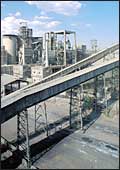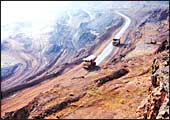 |
| Wipro's Chairman Azim Premji: After a
few bad quarters, Wipro's presence in many verticals is now
beginning to pay off |
The Merchant Of Speed
Wipro's prudence and its emphasis on verticals
make it unique among Indian IT services firms.
First things first: Wipro ranks ninth
among India's fastest growing large companies; its arch rival Infosys
Technologies comes in at #21. The fact that Wipro grew faster (by
this magazine's measure of fast growth, see page 118) should surprise
most people. One reason for that surprise is the fact that almost
a quarter of Wipro's revenues comes from its hardware and software-in-parts
(West Asia and India) division Wipro Infotech, and its consumer
care and lighting businesses. Although the company is quick to point
out that these businesses are not laggards-for instance, Wipro Infotech
grew revenues by 45 per cent and operating profit by 69 per cent
in the nine months ended December 31, 2004, as compared to the corresponding
period last year-the base effect makes the impact of these growth
percentages negligible. So, how did Wipro do it? Well, one touchy-feely
not-backed-by-numbers explanation is that the company's verticalised
strategy (it is in more verticals than any other Indian software
firm) is beginning to pay off. "Wipro has managed to positively
project the length and breadth of its services offerings,"
says Partha Iyengar, Vice President, Gartner, an it research firm.
Another, more grounded in numbers, one is that the company has achieved
its growth more profitably than its peers (although the base effect,
in terms of lower profitability to start with could play a hand
here too). For instance, although Wipro's average growth in calendar
year 2004, at 43.6 per cent, is not very different from Infosys'
at 40.17 per cent, its average growth in operating profit in the
same period is, at 54.95 per cent, significantly higher than Infosys'
35.47 per cent. There you have it.
-Rahul Sachitanand
 |
| Can you see the money? Gujarat Ambuja
plans to double capacity to 24 million tonnes |
Always Respected; Now Fast Too
Gujarat Ambuja rides the cement upturn to become
one of India's fastest growing companies.
Analysts have always admired cement
major Gujarat Ambuja. "I like Gujarat Ambuja because of its
good management," says P. Ravishankar, Vice President, ICICI
Securities. "Gujarat Ambuja is the most efficient cement player,"
adds Nilesh Shetty, Analyst, Pranav Securities. Therefore, it is
only natural that the company benefit from the current upturn in
the cement cycle to emerge one of India's fastest growing companies
this year. Anil Singhvi, Executive Director, Gujarat Ambuja, is
confident of maintaining this high growth trajectory: "Gujarat
Ambuja has a tradition of growing well above the industry average,
so we should be able to show an average volume growth of around
15-20 per cent in the years to come," he says. To achieve this,
the company plans to increase capacity from the existing level of
12.86 million tonnes to around 23-24 mt in the next five to seven
years. "This will be done through organic (increase in capacities
at existing plants) as well as inorganic growth," says Singhvi.
Growth means money, especially in an industry as capital intensive
as cement, and the company has gone about addressing this requirement
innovatively.
| INDIA'S FASTEST GROWING LARGE COMPANIES |
» National
Mineral Dev. Corp.
» Jindal
Steel & Power
» Bhushan
Steel & Strips
» Uttam
Galva Steels
» Great
Eastern Shipping
» Nagarjuna
Construction
» ABB
» Tata
Steel
» Wipro
» Gujarat
Ambuja Cements |
|
|
| Gujarat Ambuja's Singhvi: With the Holcim
deal done, he is now eyeing some acquisitions |
Gujarat Ambuja's minority investment in acc (it had an effective
stake of 8.3 per cent, acquired in December 1999) was benefiting
the company only to the tune of marginal dividend payouts. And the
company realised that it would have to spend around Rs 900 crore
buying back the 40 per cent stake private equity investors hold
in Ambuja Cement India (part of a promised exit). Gujarat Ambuja
has gotten around both challenges by bringing in Holcim. As part
of this, Holcim will buy out the private equity investors in Ambuja
Cement India, the investment arm of Gujarat Ambuja, which already
owns a 13.8 per cent stake in ACC, then acquire a 50 per cent stake
in acc through a deal with the company and an open offer. The deal,
which is cash neutral for Gujarat Ambuja, will see its effective
stake in acc increase to 16.5 per cent. And the long-term relationship
with partner Holcim will help Gujarat Ambuja in its own quest for
growth. Though the JV (joint venture) deal has a provision for Holcim
to buy out Gujarat Ambuja's stake in future, the chances of this
look remote. "We have shortlisted Holcim because it believes
in partnership (glo-bally)," says Singhvi. Since Holcim has
good experience in the use of optimising and also use of alternate
fuels, this will help Gujarat Ambuja reduce its fuel cost further.
"With a strategic partner like Holcim, Gujarat Ambuja has access
to many more foreign markets," says Rohit Singhania, an analyst
at brokerage HDFC Securities.
With the Holcim deal over, the management's focus is back on Gujarat
Ambuja Cement's balance sheet and Singhvi says the next few months
could see "deals that will add value to our own balance sheet".
-Narendra Nathan
The Cement Cycle: Where Is It Headed?
Though a cyclical commodity, cement
is a proxy for overall economic growth. that explains why the industry
has been growing at around 1.2 times India's GDP growth rate in
the past. With GDP growth expected to remain high (6-8 per cent)
over the next few years, the cement industry should grow at an average
of 10 per cent. However, this growth may be sporadic (very high
growth in one year and smaller growth or even negative growth next
year). On the supply side, drives to enhance capacity will be based
on long-term demand projection. That is why Ravishankar of ICICI
Securities says, "The cement glut of early 2000s won't be repeated
again." With demand continuing to zoom and no big greenfield
projects coming up (it takes around two years for a plant to be
commissioned), the gap between supply and demand is fast reducing.
Ergo, reasons Jaspreet Singh, an analyst at Mumbai brokerage Angel
Broking, "Cement prices next year should be higher." That
is good news for all cement companies.
Large And Fast
 |
| NMDC's iron ore mines in Bailadila, MP With
the steel sector on a roll, the company is hard-pressed to meet
demand |
National Mineral Development Corporation
With the steel sector booming, it shouldn't surprise anyone that
iron ore producer NMDC, a government-owned company (2003-04 revenues
Rs 1,532.70 crore; 2004-05 nine-month revenues Rs 1,497.97 crore),
grew the fastest in 2004. Much of that growth came from the domestic
market (almost 70 per cent of the company's revenues come from this,
as compared to 30 per cent in 1992), but there's still more to the
growth than meets the eye, insists B. Ramesh Kumar, Chairman, NMDC,
pointing to "a quantum jump in productivity" of around
25 per cent in the three months ended December 31, 2004 alone, and
efforts to tap new markets with offerings such as low-grade ores.
It shows.
-E. Kumar Sharma
Jindal Steel & Power
Another steel company makes the list, but in this case, the recipe
for growth is very different from that of NMDC. Jindal Steel &
Power (2003-04 revenues Rs 1,419.1 crore; 2004-05 nine-month revenues
Rs 1,843.77 crore) has grown largely on the strength of integration
and exports. The company owns iron ore mines in Chattisgarh and
Orissa and generates its own power, partly on waste gases and coal.
The consequent low cost of power (Rs 2.32 per unit) doesn't just
lower its own costs, but also enables it to find a ready market
for the excess generated. "The integration helps us operate
efficiently," says Navin Jindal, Managing Director, Jindal
Steel & Power. And exports help the growth cause too: they are
up 506 per cent between April and December 2004.
-Supriya Shrinate
Bhushan Steel & Strips
In 2004, Indians bought more cars (the passenger car market crossed
the magic one-million-units-a-year mark) and white goods (think
washing machines, microwave ovens, refrigerators and the like) than
ever before. And Bhushan Steel & Strips (2003-04 revenues Rs
1,574.4 crore; 2004-05 nine-month revenues Rs 1,937.5 crore), which
counts companies from these two sectors among its largest customers
(almost 50-55 per cent of its revenues comes from sales to original
equipment manufacturers, largely automobile and white goods makers)
laughed all the way to the bank. A new plant helped, admits Nitin
Johari, CFO, Bhushan Steels, adding that it enabled the company
add "value- added products like colour-coated sheets, high-tensile
strapping and outer skin panels for white goods" to its product
range. By March 31, the company hopes to have toted up exports of
Rs 1,000 crore (up from Rs 389 crore last year), and next year,
the benefits of a backward integration into hot-rolled coils (December
2004) should kick in.
-Supriya Shrinate
 |
| Uttam Galva's Miglani: The benefits of
differentiation |
Uttam Galva Steels
In 2001-02, Uttam Galva's revenues were Rs 596 crore. Last year
(2003-04), they were Rs 1,221 crore. And by 2005-06, reckons Rajinder
Miglani, the company's Chairman and Managing Director, they "should
cross the Rs 3,000-crore mark". Part of the growth can be attributed
to Miglani's opinion that "the learning process (an euphemism
for the horrors the steel industry went through) is over and we
can grow with confidence for several years from now." And part
of it comes from Uttam Galva's approach of not competing with the
heavyweights, but doing something different. "We can service
our customers better (through quicker delivery schedules, the ability
to deliver small quantities and the like)," says Miglani. That
could explain why the company exports to 110 countries.
-Narendra Nathan
Great Eastern Shipping
With the shipping business booming, it is only natural that Great
Eastern Shipping (2003-04 revenues Rs 1,351.82 crore; 2004-05 nine-month
revenues Rs 1,494.01 crore), the largest private sector shipping
company in India with a diversified fleet (in terms of territories,
trades and kinds of ships), has grown, and how. To augment its growth,
the company has embarked on a fleet-expansion drive. "Currently,
we have a committed capital expenditure of around $353 million (Rs
1,550 crore)," says K.M. Sheth, Executive Chairman, Great Eastern
Shipping. This will add 15 more ships (seven tankers and eight offshore
support vessels) to the company's fleet in the next two years. And
prevailing high shipping rates should help translate this volume
growth into revenue growth.
-Narendra Nathan
Nagarjuna Construction Company
Like most construction companies in India, Nagarjuna Construction
(2003-04 revenues Rs 762 crore; 2004-05 nine-month revenues Rs 741
crore) is growing. What's impressive about this company, however,
isn't growth, but a business model that manages risks well enough
to ensure sustainable growth. "We have a de-risked business
model as we operate across seven business verticals," says
Y.D. Murthy, Vice President (Finance and Accounts), Nagarjuna Construction.
There's enough happening in all-industrial structures and buildings,
transportation, water and environment, electrical, housing, property,
and irrigation and hydropower-right now and Murthy is convinced
that the ongoing National Highways project (the 7,300-km NSEW corridor)
can only "open up new opportunities".
-E. Kumar Sharma
 |
| ABB India's Uppal: The power sector is
on a roll and so is ABB |
ABB
Forget the troubles of the parent, ABB India (January-December
2004 revenues Rs 2,305.6 crore; January-December 2003 revenues Rs
1,503.1 crore) is on a roll. This major player in power and automation
technologies has benefited from the surge in the power sector in
India. "The country's macro-economic fundamentals are encouraging
and power sector reforms are gathering pace," says Ravi Uppal,
Vice Chairman and Managing Director. Then, there's the current investment
boom (companies are investing in fresh capacities) that bodes well
for ABB's advanced automation technologies.
-Venkatesha Babu
 |
| Burning bright: Tata Steel is on its way
to being an MNC |
Tata Steel
It is riding the boom in steel demand. And how! Sales for the
quarter ended December 31, 2004 jumped 37.87 per cent to Rs 4,090.46
crore, and net profit zoomed 99.14 per cent compared to the previous
corresponding quarter. For the nine months to December 31, 2004,
the topline grew 36.75 per cent and the bottom line, 129.61 per
cent. The company's expansion plans are also progressing well. "We're
on track to fulfil our vision of becoming a 15-million-tonne per
annum, multi-location, multinational steel company by 2010,"
says T. Mukherjee, Deputy Managing Director of Tata Steel.
Arnab Mitra
|










